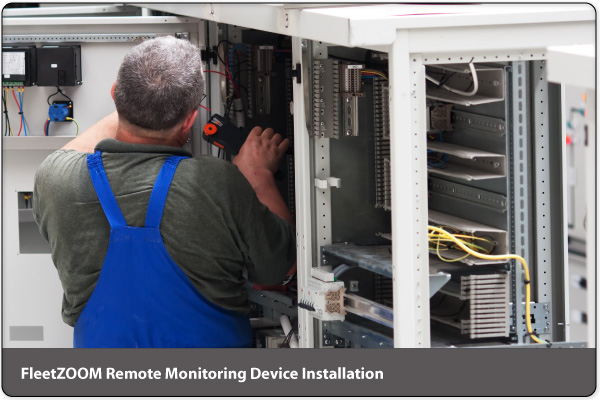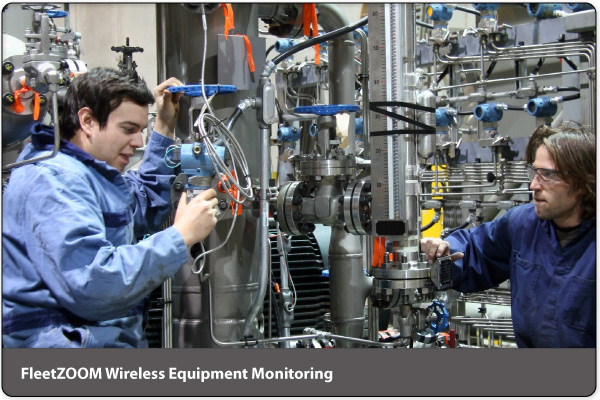Equipment Monitoring with FleetZOOM (cont'd)
FleetZOOM devices also provide remote power monitoring thanks to their internal backup
batteries. The status of main, or grid supplied power is
constantly monitored by the unit and reported as an alarm
(if desired). Each event is stored in the system any
time the status of main or grid power changes.
Data parameters and
reports can be compiled from the monitoring website over
weeks, days, months, quarters etc., to quickly tell the
equipment owner the total number of times the power has
gone out, the total amount of time it has been off with
a full list of each event and duration.
Digital inputs detect two signal states and they can
have different meanings depending on the
application. An industrial wireless remote monitor detects the digital input as either
on or off or in some cases high or low (referring
to the voltage of the signal). On the monitored
piece of equipment the signal can also be considered
normally open or normally closed. A normally open
signal typically is off or, low when the status
being monitored is normal or off, whereas a normally
closed signal operates in the opposite way. Furthermore
some digital input signals are positive or negative in their
active state. Wireless telemetry units like the FleetZOOM devices can operate with
any permutation of those signal types to support different
types of equipment.

Analog inputs read the value of electrical signals
from sensors or transducers that output voltage or
current proportionately or sometimes inversely to
the quantity of what the sensor is measuring. Most
sensors output a linear proportional signal, but in
some cases a non linear map is required to relate
the analog input signal to real-world measured value
via the signal being monitored.
Equipment monitors like the FleetZOOM devices can monitor
analog signals either as voltage (typically 0 to
5 Volts) or current (typically 4 to 20 mA). Analog
signals are used to monitor variable quantities
unlike digital inputs which are either on or
off. Examples of analog signals commonly
monitored with wireless telemetry equipment include temperatures, pressures,
flow rates, and tank levels.
Analog inputs can be used to monitor
any value that can be read by an electrical sensor
that is capable of outputting a voltage
or current. Wireless monitoring devices like the FleetZOOM units have internal
analog inputs too, which directly monitor its
DC power voltage.
Digital outputs like those found on the
FleetZOOM monitoring devices enable the system to remotely control
industrial equipment. Digital outputs can directly interface
with many PLC inputs to tell the PLC to perform a program
controlled action. Alternatively digital outputs
can directly drive external relays. Relay drive capabilities are
advantageous to wireless telemetry systems in a number of ways, most importantly this enables
the device to control equipment in an electrically isolated way.
Often digital outputs are used to turn on motors, pumps, fans or
other equipment that operates at a much higher AC voltage such
as the common 120 VAC found in normal household power, or even
3 phase 480 VAC used to power many larger motors used in pumps.
Relays, also called dry contacts, enable the digital outputs
to control a much greater current than the FleetZOOM device is able
to control directly. A digital output may provide 500 mA of
drive whereas a common relay can provide 10 Amps of switching
capacity. When considering the remote control capabilities digital
outputs add to a remote equipment monitor, the system is really more than just a
"monitor" since it can perform control functions on the same piece
of equipment it is simultaneously
monitoring.

The FleetZOOM series of wireless telemetry modules enable wireless equipment monitoring.
Digital inputs, analog inputs and digital
outputs suitable for driving external relays are all
provided by the unit.
Most wireless equipment monitors pick up the signals they are monitoring from
dry contacts, or relays on the equipment that is being
monitored, but analog inputs can be used to monitor variable
signals with a sensor that outputs a voltage (typically
0-5 Volt) or current (typically 4-20mA).
The FZ300 for example provides of 20 discreet
monitoring points; 14 digital inputs, 4 digital outputs
and 2 analog inputs. But there isn't really a limit to
how many I/O points can be monitored, with expansion modules or
use of larger wireless industrial monitors, like
the FZ400, equipment remote monitoring can be applied to almost any type of
industrial equipment, regardless of complexity or
I/O density. For more cost sensitive applications the smaller units like the
FZ100 or FZ200 can be used.
Key features of FleetZOOM monitoring devices include totally wireless operation.
No phone lines or data lines are required on the piece of equipment or the site.
The entire system is web-based, so there is no software to buy.
Utilizing cellular network infrastructure
for data transfer, FleetZOOM units essentially operate
as cell phone data acquisition devices. Thanks to their
design, they are easy to install and use too.
An internal battery backup on the RTU (remote terminal
unit) enables remote power monitoring and keeps the system operating during power
outages in addition to notifying interested personnel about
loss of power on the piece of equipment or at the site
monitored.
The system provides daily updates by email or
text. It gives immediate notification
for any remote industrial monitoring alarms or events. Each daily report
displays summary and statistical data for all monitored
signals.
Users can
access the remote monitoring system
from anywhere, be it a home on a PC, the
office, or on the road by using your smartphone.
Web-based
configuration features provide flexible options for
the sensor and transducer setup, while the online
reports and history files make exporting data for all
the events and alarms a snap.